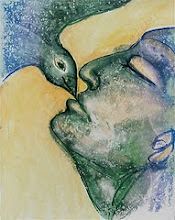+sergio+dimartino.jpg) Quindi siamo passati all'azione. Dopo una prova per prendere confidenza con la tecnica, eseguita su un disegno originale elaborato da Marko Pogacnik durante un seminario a Londra, ciascuno di noi ha iniziato a scolpire il suo cosmogramma. Prima di dare inizio al lavoro, ci siamo connessi alla pietra che giaceva dinnanzi a noi.
Quindi siamo passati all'azione. Dopo una prova per prendere confidenza con la tecnica, eseguita su un disegno originale elaborato da Marko Pogacnik durante un seminario a Londra, ciascuno di noi ha iniziato a scolpire il suo cosmogramma. Prima di dare inizio al lavoro, ci siamo connessi alla pietra che giaceva dinnanzi a noi.Pietra di Portland, una pietra calcarea di circa centocinquanta milioni di anni fa, un era relativamente recente in termini geologici. Per intenderci, quando presumibilmente quello che sarebbe diventato il continente africano era ancora fuso all'attuale America del Sud, la placca europea non era ben distinguibile e il futuro continente asiatico assomigliava molto a un drago pronto spiccare un balzo.
Una pietra formatasi per stratificazione sui fondali marini in seguito alla precipitazione di carbonato di calcio e del suo accumulo e compattazione insieme al deposito dei resti di sostanza organica derivante da animali e vegetali acquatici in via di decomposizione. Una pietra, dunque, che racchiude al suo interno, una memoria minerale e organica inarrivabile per la nostra mente.
La connessione, a livello intuitivo, ci ha permesso di entrare in risonanza e unirci al mezzo espressivo. Da quel momento si può affermare che non eravamo più da soli a scolpire ma era la pietra a suggerirci come procedere. Io, ad esempio, ho cominciato a scolpire all'esterno dell'area circolare del cosmogramma, con una convinzione e una sicurezza che si sono rivelate sorpendenti quando mi sono reso conto che quello che avevo appena fatto era assolutamente "sbagliato". Grazie a Lizzie, non ho perso né la calma né la concentrazione e qualche minuto dopo è "apparsa" una nuova parte del disegno che voleva manifestarsi cosicché il cerchio centrale galleggia adesso su una bolla a due anse.
 Tutti i processi fin qui descritti di esplorazione del territorio, elaborazione di un disegno e scultura del cosmogramma sono nati e si sono sviluppati in seno a un cerchio, in un contesto di gruppo. Un gruppo di umani che si è ritrovato con l'intento di entrare in contatto con un territorio, lasciarsi coinvolgere dalle sue dinamiche e facilitare il fluire delle energie in esso presenti attraverso la creazione di disegni comprensibili a livello intuitivo da parte di tutti i suoi abitanti.
Tutti i processi fin qui descritti di esplorazione del territorio, elaborazione di un disegno e scultura del cosmogramma sono nati e si sono sviluppati in seno a un cerchio, in un contesto di gruppo. Un gruppo di umani che si è ritrovato con l'intento di entrare in contatto con un territorio, lasciarsi coinvolgere dalle sue dinamiche e facilitare il fluire delle energie in esso presenti attraverso la creazione di disegni comprensibili a livello intuitivo da parte di tutti i suoi abitanti.Il ticchettio della mazzetta sullo scalpello e dello scalpello sulla pietra, ripetuto per tante persone quante eravamo all'opera insieme, è stato la musica che ci ha accompagnato mentre eravamo tesminoni del rivelarsi e del prender forma del Cosmogramma nel suo viaggio dal regno dei pensieri e delle emozioni alle tre dimensioni della materia.
---------------------------------------
So we set to work. We started getting confident with the new media and learning the basic techniques by carving one cosmogramme Marko Pogacnik had been drawing during the London Workshop and then each one of us started with their own cosmogrammes. Right before starting we tuned in with the stone that was lying in front of us.
Portland stone, a more or less 150 million years old limestone, so quite a young one in terms of geologic periods. When what would have most likely become Africa was still one thing with Southern America to get the picture, Europe was not yet configured and the Asiatic plate looked very much like a crouching dragon.
This kind of stone formed in a marine environment due to the precipitation of calcium carbonate on the sea floor and its sedimentation along with organic detritus from animals and plants. So this stone is packed with biological memory and a whole lot of organic intelligence we can harly imagine.

All the different experiences we've been going through, from exploring the grounds to designing a drawing and finally carving a cosmogramme, were part of a group process and were conceived and born within a Circle. A group of people who met with the intention of getting in touch with a land, getting involved with its dynamics, trying to understand its needs and facilitate the flow of its energies by means of drawings intuitively understandable by all of its inhabitants.
 The light sound of hammer upon chisel and chisel upon rock, echoed for so many times as the people at work, was the music that accompanied us while carving together and soon became a familiar and cosy motive. The perfect soundtrack for the gradually unveiling and coming into form of the Cosmogramme from the realm of thoughts and emotions to three dimensional matter.
The light sound of hammer upon chisel and chisel upon rock, echoed for so many times as the people at work, was the music that accompanied us while carving together and soon became a familiar and cosy motive. The perfect soundtrack for the gradually unveiling and coming into form of the Cosmogramme from the realm of thoughts and emotions to three dimensional matter.
























